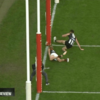- Oct 5, 2008
- 9,536
- 23,566
- AFL Club
- Hawthorn
I was hoping someone could clear up a query I had regarding the classification of a goal in the scenario where the ball crosses the line but skims the post AFTER it has cleared the goal line.
Am I right in saying that as soon as the entire ball has crossed the line it is a goal regardless if it goes on to skim the padding of the goal post there after?
I have seen a few examples which I feel fall into this category where the goal umpire has somehow over ridden the fact that the ball has crossed the line because of the incidental fact that it made contact with the post. I have even seen examples where the ball bobbles over the line and then lolls back against the padding. Again the goal umpire paid a "post behind" deferring to the fact that it had made contact with padding rather than the fact that it had cleared the line first.
The fact that it happens to hit the post should really not come into it, just as it would not come into it if the ball cleared the line by a metre then bounced on it's end back into the post.
I attach an illustration of the scenario I am referring to as reference.
Is anyone able to shed on light on this so that I am able to sleep better at night?

Am I right in saying that as soon as the entire ball has crossed the line it is a goal regardless if it goes on to skim the padding of the goal post there after?
I have seen a few examples which I feel fall into this category where the goal umpire has somehow over ridden the fact that the ball has crossed the line because of the incidental fact that it made contact with the post. I have even seen examples where the ball bobbles over the line and then lolls back against the padding. Again the goal umpire paid a "post behind" deferring to the fact that it had made contact with padding rather than the fact that it had cleared the line first.
The fact that it happens to hit the post should really not come into it, just as it would not come into it if the ball cleared the line by a metre then bounced on it's end back into the post.
I attach an illustration of the scenario I am referring to as reference.
Is anyone able to shed on light on this so that I am able to sleep better at night?













